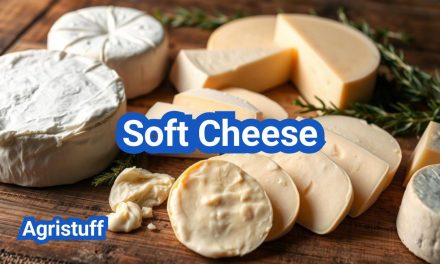Originating in the northeastern region of France, soft-ripened cow’s-milk cheese ( Soft Cheese ) has become a delicacy worldwide. Named after the district in which it is produced, this cheese has a rich history dating back to the regions near Paris.
The most esteemed versions, Brie de Meaux and Brie de Melun, are produced using unpasteurized milk, showcasing the traditional methods that have been preserved over time. This soft cheese is not only a staple in French cuisine but has also gained popularity globally for its creamy texture and mild flavor.
Key Takeaways
- Soft-ripened cow’s-milk cheese originated in northeastern France.
- The most prestigious types are Brie de Meaux and Brie de Melun.
- Traditional production methods involve unpasteurized milk.
- This cheese is renowned for its creamy texture and mild flavor.
- It is a versatile ingredient in various culinary contexts.
The Rich Heritage of Brie Cheese
The story of Brie cheese is deeply intertwined with French culture and history. This iconic cheese has been a part of French tradition for centuries, with its origins tracing back to the Île-de-France region.
Origins in the Île-de-France Region
Brie cheese originated in the Île-de-France region, where it was first produced in the 8th century. The region’s unique terroir and climate contributed to the development of Brie’s distinctive characteristics. The cheese quickly gained popularity among the local nobility, becoming a staple in French aristocratic cuisine.
Historical Significance in French Culture
Brie cheese played a significant role in French culture, particularly during the medieval period. It was often served at royal courts and was a favorite among French monarchs. The cheese became known as the “Queen’s cheese” due to its association with the royal family. In 1980, Brie was granted Appellation d’Origine Contrôlée (AOC) status, recognizing its unique production methods and cultural significance.
Brie’s Journey to International Fame
Brie cheese gained international recognition in the late 19th and 20th centuries, as French cuisine spread globally. Today, Brie is enjoyed worldwide, with various countries producing their own versions of this beloved cheese. Despite this, the traditional methods of Brie production remain unchanged, preserving its rich heritage and cultural significance.
What Makes Brie Cheese Special

As a quintessential French cheese, Brie is renowned for its soft-ripened texture and rich flavor profile. This delicacy has captured the hearts of cheese enthusiasts worldwide, thanks to its unique characteristics.
Defining Characteristics of Soft-Ripened Cheese
Brie is classified as a soft-ripened cheese, meaning it ripens from the outside in. This process involves the growth of beneficial mold on the rind, which breaks down the fats and proteins, resulting in a creamy texture. The ripening process is carefully controlled to achieve the perfect balance between the outer rind and the inner cheese.
The Distinctive Bloomy Rind
One of Brie’s most striking features is its white bloomy rind, formed by the introduction of Penicillium candidum during the cheese-making process. This rind not only adds to the cheese’s aesthetic appeal but also plays a crucial role in its flavor development.
Flavor Profile and Creamy Texture
The taste of Brie cheese is characterized by its rich, buttery flavor, often accompanied by earthy and mushroom notes. As the cheese ripens, it becomes increasingly creamy, making it a delight to spread on crackers or bread.
| Characteristics | Description |
|---|---|
| Rind | White bloomy rind |
| Texture | Creamy, soft-ripened |
| Flavor Profile | Rich, buttery, earthy |
Exploring Traditional and Modern Brie Varieties
Brie cheese has a rich diversity of varieties, ranging from traditional to modern interpretations. This diversity is a testament to the cheese’s adaptability and its ability to cater to different tastes and preferences.
Brie de Meaux AOP: The King of Cheeses
Brie de Meaux AOP is one of the most renowned traditional varieties of Brie. Produced in the Île-de-France region, this cheese is made from cow’s milk and is known for its creamy texture and mild, earthy flavor. The “AOP” designation (Appellation d’Origine Protégée) signifies that Brie de Meaux is produced according to traditional methods and within a specific geographic area, ensuring its authenticity and quality.
Commercial Brie Variations Worldwide
While traditional Brie varieties like Brie de Meaux and Brie de Melun remain popular, modern commercial variations have emerged worldwide. These include double-cream and triple-cream Brie, which offer an even richer and creamier experience. Additionally, some producers experiment with different types of milk, such as goat’s or sheep’s milk, to create unique flavor profiles.
Soft-Ripened Cheese Characteristics
Brie is classified as a soft-ripened cheese, meaning it is aged from the outside in. This process involves introducing a type of mold, typically Penicillium camemberti, to the cheese’s surface, which gradually penetrates to the core. The result is a cheese with a characteristic white rind and a creamy, spreadable interior. The soft-ripened nature of Brie contributes to its delicate flavor and velvety texture.
The variety of Brie cheese available today caters to a wide range of palates and culinary applications. Whether you’re a traditionalist who prefers Brie de Meaux or an adventurous eater looking to try modern variations, there’s a Brie cheese to suit every taste.
Understanding Cream Content Classifications

Understanding the different cream content classifications is key to appreciating Brie cheese fully. Brie cheese is categorized based on its cream content, which significantly influences its texture and flavor profile.
Standard Brie: The Classic Formula
Standard Brie, also known as Brie de Meaux, is made with a mixture of milk and cream. It has a fat content of around 20-30%, giving it a rich but still relatively light texture. This classic version is known for its bloomy rind and creamy interior.
Double-Cream Brie: Elevated Richness
Double-cream Brie has a higher cream content than standard Brie, resulting in a fat content of approximately 60%. This increased richness gives double-cream Brie a luxurious, velvety texture that melts in the mouth. It’s a favorite among cheese connoisseurs for its decadent taste.
Triple-Cream Brie: Ultimate Indulgence
Triple-cream Brie takes richness to the next level with a fat content of around 75% or more. This indulgent cheese is incredibly creamy and is often served as a special treat. The high fat content makes it perfect for spreading on crackers or bread.
The cream content classifications of Brie cheese are not just about the fat percentage; they also reflect the cheese’s overall character and usage in culinary applications. As noted by cheese expert, “The richness of Brie is directly related to its cream content, making each classification unique in its own right.”
“The richness of Brie is directly related to its cream content, making each classification unique in its own right.” – Cheese Expert
| Brie Classification | Approximate Fat Content | Description |
|---|---|---|
| Standard Brie | 20-30% | Classic version with a bloomy rind and creamy interior |
| Double-Cream Brie | 60% | Luxurious, velvety texture with a rich taste |
| Triple-Cream Brie | 75% or more | Incredibly creamy, perfect for spreading |
The Science Behind Brie’s Ripening Process
The ripening process of Brie cheese is a complex biochemical transformation that involves various microorganisms and enzymes. This process is crucial for developing the cheese’s characteristic flavor, texture, and appearance.
Role of Penicillium Camemberti
Penicillium camemberti is a type of mold that plays a pivotal role in the ripening of Brie cheese. It grows on the surface of the cheese, forming a white rind that not only protects the interior but also contributes to the cheese’s flavor and texture. This mold breaks down the proteins and fats within the cheese, leading to the development of its characteristic creamy interior and earthy flavor.
Protein Breakdown During Affinage
During affinage, the proteins in Brie cheese are broken down into smaller peptides and amino acids. This process, facilitated by enzymes produced by Penicillium camemberti, results in a softer, more spreadable texture. The breakdown of proteins also contributes to the development of the cheese’s complex flavor profile.
Fat Content and Mouthfeel Development
The fat content in Brie cheese significantly influences its mouthfeel and overall texture. As the cheese ripens, the fat molecules are broken down, contributing to a rich, creamy sensation. The high fat content in Brie, especially in double-cream and triple-cream varieties, enhances the cheese’s luxurious mouthfeel and flavor.
How to Make Brie Cheese: Step-by-Step Process
The art of making Brie cheese involves several crucial steps, from milk selection to the final salting process. Crafting this soft-ripened cheese requires attention to detail and a understanding of the cheese-making process.
Selecting and Preparing the Milk
The first step in Brie cheese production is selecting high-quality milk. Raw cow’s milk is traditionally used, but pasteurized milk can also be employed. The milk should be rich in fat and protein to produce the desired creamy texture. It’s essential to heat the milk to around 86°F (30°C) before adding the cheese cultures.
Curdling and Cutting Techniques
After preparing the milk, the next step is curdling. Rennet is added to the milk, causing it to coagulate. The curd is then cut into small pieces to release whey and create a smooth, even texture. This process is crucial for developing the characteristic creamy consistency of Brie.
Molding and Initial Draining Methods
The curds are then transferred to Brie molds, which give the cheese its distinctive shape. The molds are typically made of perforated material to allow for drainage. As the curds drain, they form a white rind that is characteristic of Brie cheese. The initial draining process is critical for setting the cheese’s texture.
Proper Salting Approaches
Once the cheese has been molded and initially drained, it’s time for salting. Salt is applied to the surface of the cheese, which helps to control the growth of unwanted bacteria and enhances the flavor. Proper salting is essential for developing Brie’s distinctive taste and aroma.
By following these steps carefully, cheese enthusiasts can create authentic Brie cheese at home. The process requires patience and attention to detail, but the result is a rich, creamy cheese that’s perfect for serving on its own or paired with various accompaniments.
Essential Equipment for Brie Production

The production of Brie cheese relies heavily on specialized equipment to achieve its characteristic soft-ripened texture and bloomy rind.
To produce high-quality Brie, cheesemakers must invest in the right tools and facilities. The type of equipment used can vary significantly between industrial and artisanal producers.
Industrial vs. Artisanal Tools
Industrial-scale Brie production utilizes mechanized equipment for tasks such as curdling, cutting, and molding. In contrast, artisanal producers often prefer traditional, manual tools that allow for greater control over the cheesemaking process.
Key differences between industrial and artisanal tools include:
- Scale of production
- Level of automation
- Material and construction of equipment
Specialized Molds and Their Functions
Brie cheese is typically formed in cylindrical molds that allow the cheese to drain and develop its characteristic shape.
The molds used for Brie production are designed to facilitate even drainage and promote the growth of the white mold on the surface.
Aging Rooms and Climate Control Systems
Aging rooms with precise climate control are essential for developing Brie’s distinctive flavor and texture.
These rooms maintain optimal temperature and humidity levels, typically between 10°C to 12°C and 90% to 95% relative humidity.
Quality Testing Instruments
To ensure consistent quality, Brie producers use various testing instruments to monitor parameters such as pH, moisture content, and microbial activity.
| Testing Instrument | Purpose |
|---|---|
| pH Meter | Monitor acidity levels |
| Moisture Analyzer | Measure cheese moisture content |
| Microbial Testing Kit | Detect and quantify microorganisms |
How to Select the Perfect Brie Cheese

Selecting the perfect Brie cheese can elevate your culinary experience to new heights. When choosing Brie, there are several factors to consider to ensure you’re getting a high-quality product.
Visual Indicators of Quality
The first step in selecting Brie is to examine its appearance. Look for a white bloomy rind, which is a sign of proper aging. Avoid Brie with overly dark or uneven rinds, as this can indicate poor quality or over-ripeness.
Texture Assessment Techniques
Next, assess the texture of the Brie. A high-quality Brie should be soft and creamy to the touch, but not runny. If possible, gently press the cheese to check its firmness.
Aroma Evaluation Methods
The aroma of Brie is a crucial indicator of its quality. Bring the cheese to your nose and take a sniff. A good Brie should have a mushroom-like aroma, which is a result of the Penicillium camemberti mold. If the cheese smells strongly of ammonia, it may be overripe.
Price Considerations and Value
Finally, consider the price of the Brie. While it’s true that you often get what you pay for, extremely expensive Brie isn’t always the best. Compare prices and look for value for money. Consider the size, age, and production methods when evaluating the price.
Mastering Brie Storage and Handling

To enjoy Brie cheese at its best, it’s essential to understand the correct methods for storing and handling it. Proper techniques can significantly impact the cheese’s quality and shelf life.
Optimal Temperature and Humidity Conditions
Brie cheese should be stored in the refrigerator at a consistent temperature between 35°F and 45°F (2°C and 7°C). Maintaining the right humidity is also crucial; the cheese should be kept in an environment with moderate humidity to prevent it from drying out.
Best Wrapping Materials and Methods
Wrapping Brie cheese in the right material is vital for maintaining its quality. Use breathable materials like wax paper or aluminum foil with holes to allow for air exchange, rather than plastic wrap, which can trap moisture and cause the cheese to spoil more quickly.
Understanding Shelf Life Expectations
The shelf life of Brie cheese varies depending on its age and storage conditions. Generally, a young Brie can last up to two weeks when stored properly, while an aged Brie might have a shorter shelf life due to its more delicate nature.
Recognizing Signs of Improper Storage
Signs that Brie cheese has been stored improperly include an overly strong or ammonia-like smell, visible mold beyond the normal white rind, or a slimy texture. If you notice any of these signs, it’s best to discard the cheese to avoid potential health risks.
By mastering the art of Brie storage and handling, you can enjoy this delicious cheese at its best, preserving its unique flavor and creamy texture.
The Art of Serving Brie Cheese

The experience of enjoying Brie cheese is significantly enhanced when it’s served correctly, with the right temperature and accompaniments. Serving Brie is an art that elevates this luxurious cheese to its full potential.
Achieving Ideal Serving Temperature
Brie cheese is best served at room temperature, which allows its creamy texture and flavors to be fully appreciated. To achieve this, remove Brie from the refrigerator about 30 minutes to an hour before serving. This waiting period ensures that the cheese is at its most palatable state.
Proper Cutting Techniques
Cutting Brie requires some finesse. The traditional method involves cutting wedges from the center outwards, much like slicing a pie. This technique helps maintain the cheese’s integrity and prevents it from crumbling. For a wheel of Brie, start by cutting along the radius, then slice into wedges. This method ensures that each guest receives a fair share of the cheese’s creamy center and its bloomy rind.
To Rind or Not to Rind: Making the Choice
The rind of Brie is edible and contributes to its overall flavor profile. However, personal preference plays a significant role in whether to include or exclude it. For a more authentic Brie experience, serve with the rind intact. If guests are hesitant, offer a choice or provide a separate serving without the rind.
Creating the Perfect Cheese Board
A well-curated cheese board is essential for serving Brie. Start with a variety of crackers and bread, such as baguette slices or water crackers. Complement Brie with fruits like grapes, figs, or apple slices, and nuts such as almonds or walnuts. Consider adding a sweet element like honey or fig jam to balance the savory flavors of the cheese.
| Item | Description | Pairing Suggestion |
|---|---|---|
| Brie Cheese | Soft-ripened, creamy cheese | Fig jam, apple slices |
| Baguette Slices | Crusty, fresh bread | Brie, honey |
| Grapes | Fresh, sweet fruit | Brie, nuts |
Perfect Pairings with Brie Cheese

Whether you’re a cheese aficionado or a casual enthusiast, discovering the perfect pairings for Brie cheese can elevate your culinary adventures. Brie, with its creamy texture and mild, earthy flavors, offers a versatile canvas for a variety of accompaniments.
Wine Companions: Red, White, and Sparkling
Selecting the right wine to pair with Brie can enhance its flavor profile. For a classic combination, try pairing Brie with a Chardonnay or Sauvignon Blanc. If you prefer red wine, a Pinot Noir can complement Brie’s creamy texture. For a celebratory touch, a glass of Champagne pairs exquisitely with Brie, especially during special occasions.
- Chardonnay: Buttery notes complement Brie’s richness
- Sauvignon Blanc: Crisp acidity cuts through Brie’s creaminess
- Pinot Noir: Light tannins pair well with Brie’s soft texture
- Champagne: Bubbles and toasty flavors enhance Brie’s elegance
Complementary Fruits and Nuts
Fruits and nuts are natural pairing companions for Brie. Sliced apples, grapes, and figs provide a sweet contrast to Brie’s savory flavors. Nuts like almonds and walnuts add a satisfying crunch. For a simple yet elegant snack, arrange Brie on a platter with a selection of fresh fruits and nuts.
- Apples: Crisp texture and sweetness
- Grapes: Juicy and sweet, perfect for balancing richness
- Figs: Sweet, jammy flavor complements Brie’s earthiness
- Almonds: Crunchy texture and nutty flavor
Bread and Cracker Selections
The right bread or cracker can elevate the Brie experience. Traditional French bread or baguette slices are classic choices. For a different twist, try water crackers or wheat thins, which provide a neutral background that won’t overpower Brie’s delicate flavors.
- Baguette: Classic French pairing
- Water Crackers: Neutral flavor
- Wheat Thins: Crunchy texture
Sweet Accompaniments: Honey, Jams, and Preserves
For a touch of sweetness, pair Brie with honey, fruit jams, or preserves. Fig jam is a particularly popular choice, as its sweet, savory flavor complements Brie’s richness. Other options include quince paste or honey, which add a floral note to the cheese.
“The combination of Brie and fig jam is a match made in heaven, offering a balance of sweet and savory that delights the palate.”
By exploring these pairing options, you can create a rich and varied Brie experience that suits any occasion, from casual gatherings to elegant dinner parties.
Delicious Brie Cheese Recipes to Try

Exploring the world of Brie recipes opens up a realm of culinary possibilities. Brie cheese is a versatile ingredient that can elevate various dishes, from simple appetizers to complex main courses and even sweet desserts.
Classic Baked Brie Variations
Baked Brie is a crowd-pleaser, especially during the holiday season. To make a classic baked Brie, wrap a wheel of Brie in puff pastry, ensuring it’s fully enclosed. Bake at 400°F (200°C) for about 15-20 minutes, or until the pastry is golden brown. You can enhance this recipe by adding honey, nuts, or fruit preserves on top of the Brie before wrapping it in pastry.
For a twist, try using different types of pastry or adding herbs and spices to the Brie. Some variations include:
- Fig and Prosciutto Baked Brie: Add fig jam and prosciutto slices on top of the Brie for a sweet and savory combination.
- Spicy Baked Brie: Mix some red pepper flakes into the Brie or sprinkle them on top before baking for an added kick.
Savory Brie Appetizers and Bites
Brie can be used in a variety of savory appetizers and finger foods. One popular recipe is Brie and Fresh Fruit Tartine, where you top toasted baguette slices with Brie, fresh fruit, and a drizzle of honey. Another option is Brie and Charcuterie Board, featuring Brie alongside cured meats, crackers, and garnishes like grapes and figs.
For a more substantial appetizer, consider making Brie Stuffed Mushrooms or Brie and Bacon Wrapped Dates. These bite-sized treats are perfect for parties and gatherings.
Main Dishes Featuring Brie
Brie can also be incorporated into main dishes, adding richness and depth to various recipes. One example is Brie and Mushroom Risotto, where you stir in Brie towards the end of cooking, allowing it to melt and blend with the Arborio rice and mushrooms.
Another idea is to use Brie in pasta dishes, such as Brie and Spinach Stuffed Shells or Brie and Chicken Crepes. The creamy texture of Brie pairs well with pasta, making for a satisfying meal.
Sweet Brie Dessert Applications
While Brie is often associated with savory dishes, it can also be used in sweet desserts. A simple yet elegant dessert is Baked Brie with Fruit, where you bake Brie with fruit like apples or pears and serve it with crackers or bread.
For a more decadent treat, try making a Brie Cheesecake. This involves blending Brie with cream cheese, eggs, and sugar, then baking it in a water bath. The result is a creamy, rich dessert that’s sure to impress.
Nutritional Profile and Health Benefits

Understanding the nutritional profile of Brie cheese can help consumers make informed dietary choices. Brie is a rich source of various nutrients, but it is also high in fat and calories.
Caloric Content and Macronutrients
Brie cheese is known for its high caloric content, primarily due to its fat content. A 100-gram serving of Brie can contain approximately 334 calories, with about 28 grams of fat. However, it is also a good source of protein, providing around 20 grams per 100 grams.
Vitamins and Minerals in Brie
Brie cheese is a good source of several vitamins and minerals, including calcium, phosphorus, and vitamins B12 and B2. These nutrients are essential for maintaining healthy bones, teeth, and various bodily functions.
Potential Health Benefits
Despite its high calorie and fat content, Brie cheese can offer several health benefits when consumed in moderation. The calcium in Brie supports bone health, while the protein can aid in muscle maintenance and repair.
Portion Control Recommendations
To enjoy Brie cheese as part of a balanced diet, it’s essential to practice portion control. A serving size of about 1 ounce (28 grams) per sitting is recommended. This allows consumers to reap the nutritional benefits while minimizing the intake of excessive calories and fat.
| Nutrient | Amount per 100g |
|---|---|
| Calories | 334 |
| Fat | 28g |
| Protein | 20g |
| Calcium | 180mg |
| Vitamin B12 | 1.4mcg |
Brie vs. Camembert: Understanding the Key Differences
Brie Cheese and Camembert Cheese, though both French in origin, have distinct differences that set them apart in the world of cheese. Understanding these differences can enhance appreciation for each cheese’s unique qualities.
Origin and Historical Divergence
Brie originates from the Île-de-France region, while Camembert hails from Normandy. Their historical paths diverged due to regional cheese-making traditions and local milk production characteristics.
Size, Shape, and Production Variations
Brie is typically larger and has a white, bloomy rind, while Camembert is smaller, often cylindrical, with a similar rind. Production methods vary, with Brie often made from cow’s milk and Camembert traditionally from raw milk.
Flavor and Texture Comparisons
Brie tends to be milder and creamier, while Camembert has a stronger, earthier flavor. Texture-wise, Brie is generally softer and more spreadable when ripe.
Best Uses for Each Cheese Type
Brie is ideal for baking and serving on cheese boards, while Camembert is great for individual servings or paired with fruit. Both are versatile, but their unique characteristics make them suited to different culinary applications.
Embracing the Timeless Appeal of Brie
Brie cheese has captivated palates for centuries with its rich heritage and distinctive qualities. As a quintessential French cheese, Brie embodies the essence of gourmet cuisine, offering a unique experience that blends tradition with versatility.
The timeless appeal of Brie lies in its creamy texture, bloomy rind, and nuanced flavor profile, making it a favorite among cheese enthusiasts. From its origins in the Île-de-France region to its global popularity, Brie has evolved while maintaining its characteristic charm.
Whether enjoyed on its own, paired with wine and accompaniments, or incorporated into various recipes, Brie cheese continues to delight. Its adaptability in culinary applications, from baked Brie to savory dishes, underscores its enduring appeal.
As a gourmet delight, Brie cheese invites exploration and appreciation. Discovering the perfect Brie, understanding its production process, and mastering its serving techniques can elevate any culinary experience, showcasing the cheese’s timeless allure.
FAQ
What is Brie cheese?
Brie cheese is a type of soft-ripened cheese originating from the Île-de-France region, known for its creamy texture and bloomy rind.
What are the different types of Brie cheese?
There are several types of Brie cheese, including traditional varieties like Brie de Meaux and Brie de Melun, as well as modern variations found worldwide.
How is Brie cheese made?
Brie cheese is made through a process involving milk selection and preparation, curdling and cutting, molding and draining, and proper salting approaches.
What is the difference between standard, double-cream, and triple-cream Brie?
The difference lies in the cream content, with standard Brie having a classic formula, double-cream Brie having elevated richness, and triple-cream Brie being the ultimate indulgence.
How should Brie cheese be stored?
Brie cheese should be stored at optimal temperature and humidity conditions, wrapped in the right materials, and consumed within its shelf life expectations.
How do you serve Brie cheese?
Brie cheese should be served at the ideal temperature, cut properly, and presented on a cheese board with complementary accompaniments.
What pairs well with Brie cheese?
Brie cheese pairs well with wine, fruits, nuts, bread, and crackers, as well as sweet accompaniments like honey and jams.
Is Brie cheese healthy?
Brie cheese has a rich nutritional profile, with potential health benefits, but it should be consumed in moderation due to its caloric content.
What is the difference between Brie and Camembert?
Brie and Camembert differ in their origin, size, shape, production variations, flavor, and texture, making them suitable for different uses.
Can you bake Brie cheese?
Yes, Brie cheese can be baked, and it’s a popular way to enjoy it, often served as a warm, gooey appetizer or dessert.
Is the rind of Brie cheese edible?
Yes, the rind of Brie cheese is edible and can be consumed along with the creamy interior.
How long does Brie cheese last?
The shelf life of Brie cheese depends on storage conditions, but it typically ranges from a few days to a few weeks.
Can you freeze Brie cheese?
Freezing Brie cheese is not recommended, as it can affect its texture and flavor.
Conclusion of: Brie Cheese
What Is Brie Cheese and Why It Matters
Brie Cheese is a soft-ripened cow’s milk cheese celebrated for its buttery interior and delicate white rind. Originating from the historic Brie region east of Paris, Brie Cheese achieved worldwide popularity thanks to its approachable flavor, creamy texture, and versatility on the table. For U.S. readers, Brie Cheese offers a gateway into traditional European affinage while also being widely available from domestic makers who craft pasteurized, Brie-style wheels. This balance of heritage and accessibility makes Brie Cheese a staple for cheese boards, snacks, and simple cooking at home. Learn more about Brie Cheese (Britannica)
Protected Originals: Brie de Meaux and Brie de Melun
When people mention authentic Brie Cheese, they often refer to Brie de Meaux and Brie de Melun—two protected AOP cheeses that encode geography, milk handling, mold-ripening, minimum ripening times, and sensory traits. Brie Cheese under these AOP names is made within a defined zone near Paris and typically uses raw cow’s milk, hand-ladling, dry salting, and careful cave maturation. While U.S. shoppers can’t always find these specific wheels, learning about them helps explain the classic texture and flavor that define true Brie Cheese. Official Brie de Meaux AOP specification (INAO)
Common Styles of Brie Cheese on U.S. Shelves
Beyond the protected French names, you’ll see domestic Brie Cheese and “double-cream” or “triple-cream” styles. These Brie Cheese variations add cream for a richer paste and are made with pasteurized milk to meet U.S. regulations and mainstream tastes. You may also find flavored Brie Cheese options (herbs, truffle, peppercorn) that keep the soft-ripened bloom but layer in extra aromatics. Exploring these styles helps you compare richness, salt levels, and meltability when planning snacks and simple hot dishes with Brie Cheese. Brie overview and serving ideas (Wisconsin Cheese)
A Rare Style of Brie Cheese: Brie Noir
An intriguing outlier is Brie Noir, a very long-aged version that begins life much like traditional Brie Cheese but matures for many months. Over time it darkens, firms up, and develops a powerful, almost caramelized aroma that fans adore. While not common in the U.S., Brie Noir illustrates how profoundly age can transform Brie Cheese, highlighting the role of time, temperature, and rind flora in shifting texture and flavor. What is Brie Noir? (Culture Cheese Magazine)
Milk, Cultures, and Rennet: The Foundations of Brie Cheese
Every wheel of Brie Cheese begins with fresh cow’s milk, starter cultures that acidify the milk, and rennet to set the curd. For Brie Cheese, curds are handled gently to retain moisture, which later becomes the silky body you spread on bread. The right culture blend drives balanced acidity and flavor development, setting up the bloomy rind to ripen Brie Cheese from the surface inward during maturation. Cheesemaking Technology eBook (University of Guelph)
Hand-Ladling and Molds: How Brie Cheese Gets Its Shape
Artisans typically hand-ladle soft curd into round molds, a method that preserves the delicate texture of Brie Cheese. Draining is mostly gravity-driven, and the rounds are turned several times for even whey expulsion. Traditional specifications for protected styles detail the mold size, turning schedule, and dry-salting practices that ensure consistent texture and rind development. These old-school steps explain the supple, creamy character that sets Brie Cheese apart from firmer cheeses. Brie de Melun AOP dossier (EU eAmbrosia)
Bloomy Rind Biology on Brie Cheese
The thin, snowy rind on Brie Cheese comes from selected surface molds, most notably Penicillium camemberti, which grow under cool, humid conditions. As they metabolize, these molds raise surface pH and partially break down proteins and fats, giving Brie Cheese its mushroomy aroma and luscious, spreadable paste. Understanding the rind’s biology helps you judge ripeness and explains why Brie Cheese prefers breathable wraps instead of tight plastics. About Penicillium (Britannica)
Ripening & Readiness: How to Read a Brie Cheese Wedge
Ripening in Brie Cheese begins at the rind and moves toward the center; the outer layer softens first. A well-timed Brie Cheese slice will have a thin, white rind, a creamy band near the surface, and a slightly firmer heart, all smelling pleasantly of mushrooms and cream. If ammonia dominates, Brie Cheese may be overripe. Serve at room temperature for aroma and texture to shine. Cheese ripening basics (Britannica)
Equipment for Making Brie Cheese
Commercial and artisan plants use jacketed vats or pasteurizers, curd knives or harps, perforated ladles, round Brie Cheese molds with mats, draining tables, salting areas, and controlled ripening rooms with regulated temperature, humidity, and airflow. Sanitation systems (CIP) and environmental monitoring are essential because the surface flora that define Brie Cheese thrive best in a clean, well-managed environment. Plant & process references (University of Guelph)
Processing Steps: From Milk to Finished Brie Cheese
A typical flow for Brie Cheese is: receive and standardize milk; pasteurize (for non-AOP styles) or use approved raw milk; inoculate with starter cultures; add rennet and set; cut gently; rest; hand-ladle into round molds; allow gravity draining with scheduled turns; dry salt; apply or encourage bloom; ripen under cool, humid conditions until a uniform white rind forms; wrap in breathable paper; hold cold to stabilize for shipping. Each step shapes the texture, aroma, and clean, buttery finish of Brie Cheese. Soft-ripened process overview (University of Guelph)
Standards and Labeling for Brie Cheese (U.S. & EU)
In the U.S., soft-ripened cheeses related to Brie Cheese fall under cheese identity standards in 21 CFR Part 133, which govern definitions and composition. In the EU, AOP rules define terroir, production methods, and minimum ages for protected names like Brie de Meaux and Brie de Melun. Reading labels helps consumers distinguish between traditional AOP Brie Cheese and excellent domestic Brie-style cheeses made for the U.S. market. Cheese standards (eCFR, 21 CFR Part 133)
Food Safety & Hygiene Considerations for Brie Cheese
Because surface-ripening elevates rind pH, plants maintain strict hygiene to keep Brie Cheese safe and consistent. For consumers, pasteurized Brie Cheese is widely available in the U.S., and standard refrigeration plus clean handling are key. People at higher risk for listeriosis should consult guidance on soft cheeses and choose pasteurized Brie Cheese when advised by public-health resources. CDC guidance on soft cheeses
Flavor & Texture: What Great Brie Cheese Should Deliver
A well-made Brie Cheese tastes creamy, mild, and slightly nutty, with aromas of white mushrooms and fresh cream. The rind on Brie Cheese should be thin, edible, and evenly white; the paste should be pale, supple, and only gently oozing at room temperature. These traits signal a balanced bloom and a ripening schedule that preserved the cheese’s buttery core. Sensory profile notes (Britannica)
How to Use Brie Cheese in Everyday Cooking
Brie Cheese shines on boards with apples, pears, nuts, and honey; it spreads beautifully on warm baguette. In the kitchen, Brie Cheese melts gently into sandwiches, brings silkiness to omelets, and bakes well when wrapped in pastry or warmed on parchment. Keep seasonings light so the delicate character of Brie Cheese remains front and center. Serving & pairing ideas (Wisconsin Cheese)
Buying, Storing, and Serving Brie Cheese
Look for Brie Cheese with an even, white rind and a pleasant mushroomy aroma. Store Brie Cheese refrigerated in its original wrap or breathable cheese paper, then let it sit at room temperature for 30–60 minutes before serving. For meal planning and storage times, general consumer guidance tools can help you keep Brie Cheese fresh and flavorful. FoodKeeper storage guidance (FoodSafety.gov)
How to Spot Authentic Labels for Brie Cheese
If you want the traditional French experience, look for AOP designations—especially the names Brie de Meaux and Brie de Melun—on the label. Many excellent American Brie Cheese options simply say “Brie,” “double-cream,” or “triple-cream.” Understanding these terms lets you choose the exact Brie Cheese style—authentically French or American-crafted—that fits your taste and recipe needs. EU GI Register (eAmbrosia)
Summary of Processing Steps & Equipment for Brie Cheese
In short: Brie Cheese relies on gentle curd handling, round molds, gravity draining with turns, dry salting, and cool, humid ripening to build a thin, edible bloom and a buttery paste. Equipment mirrors each step—vats or pasteurizers, knives/harps, ladles, molds and mats, salting tables, and controlled ripening rooms—while sanitation and airflow management keep Brie Cheese safe and consistent from make room to market. Process & equipment reference (University of Guelph)
Final Thought
Brie Cheese endures because it blends comfort and elegance: a delicate rind, a silky interior, and aromas that reward patience and proper serving temperature. Whether you reach for a protected French original or a domestic double-cream round, give Brie Cheese a few minutes to breathe, pair it with simple accompaniments, and let its balanced richness do the rest.
Sources & References
- Encyclopaedia Britannica – Brie cheese
- INAO – Brie de Meaux AOP specification (FR)
- EU eAmbrosia – Brie de Melun AOP dossier
- EU Geographical Indications Register
- eCFR – 21 CFR Part 133 (U.S. cheese standards)
- University of Guelph – Cheese Making Technology eBook
- CDC – Listeria & soft cheeses
- Wisconsin Cheese – Brie guide & uses
- Culture Cheese Magazine – Brie Noir










